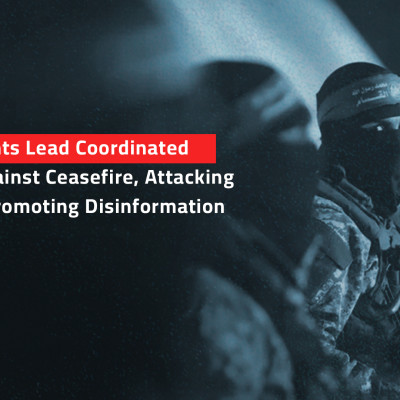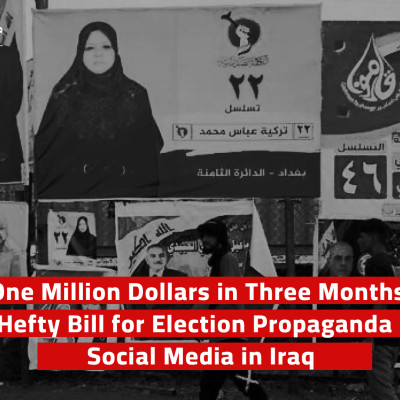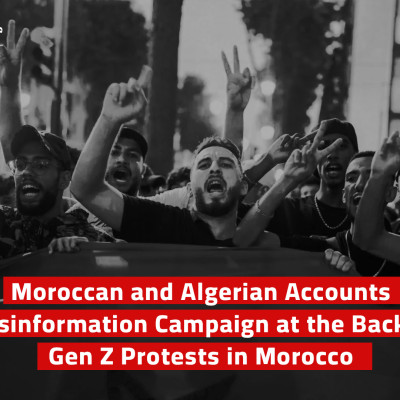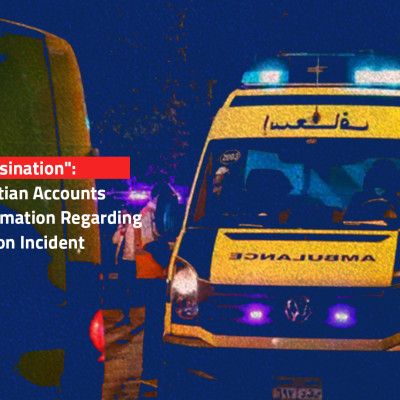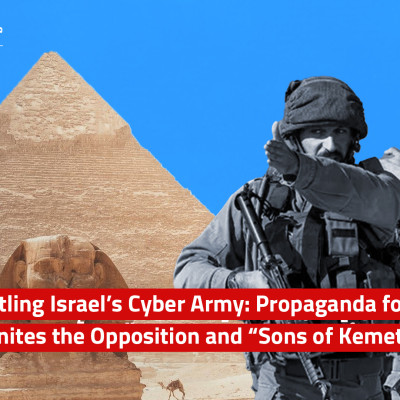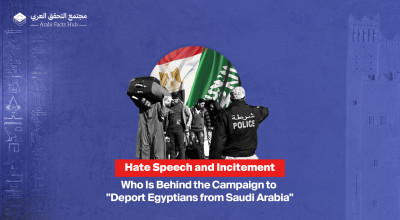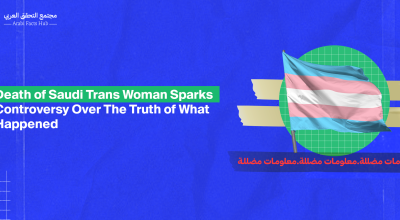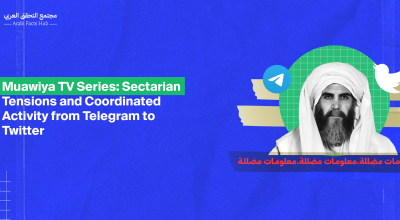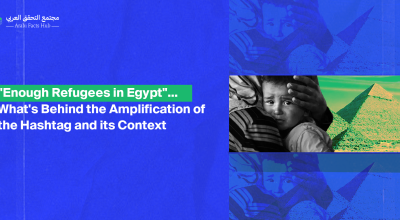"Internationalizing the Holy Mosques": A “Kemetian” Campaign Against Saudi Arabia with Emirati Involvement
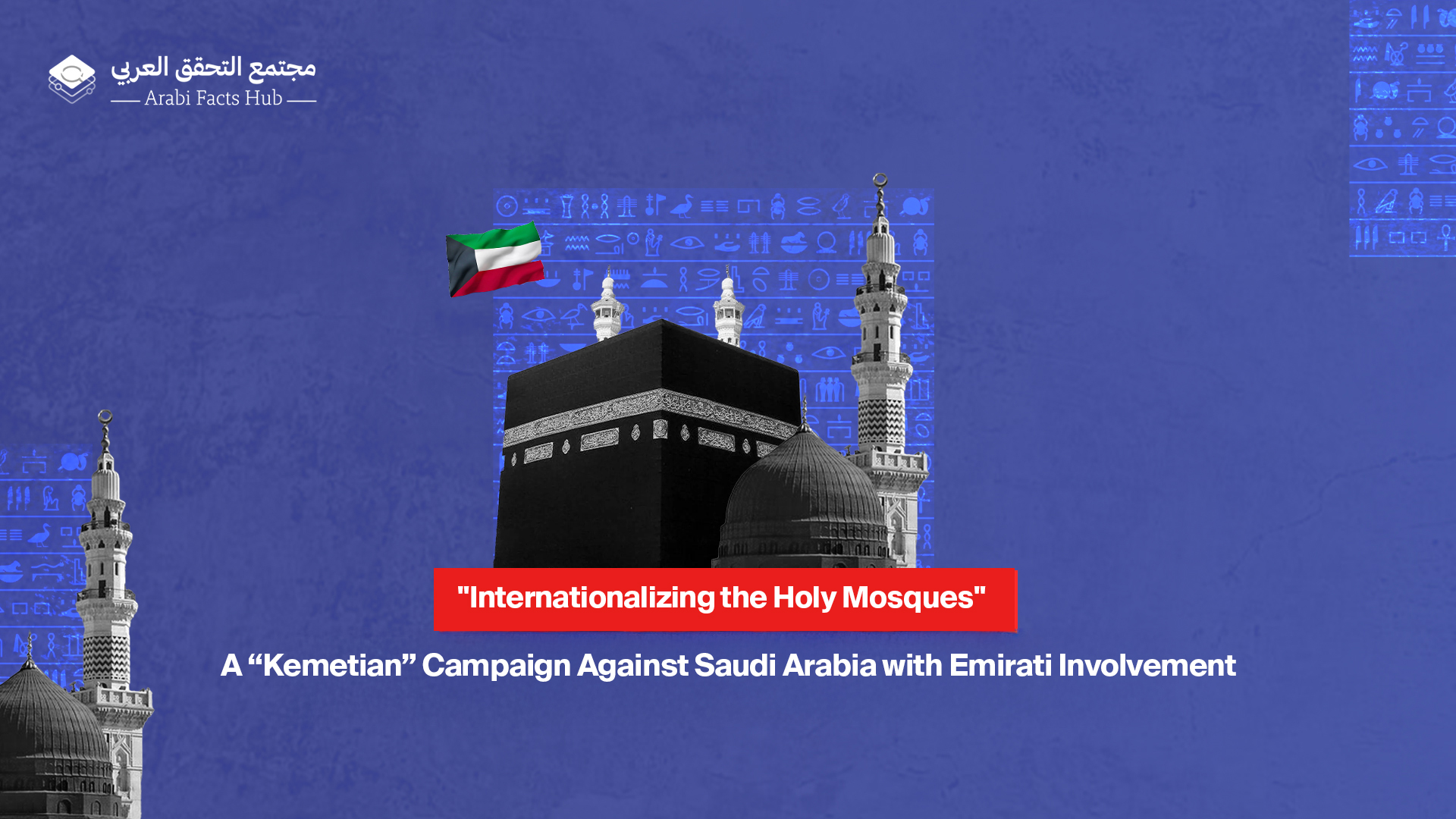
Following the widespread circulation of posts on social media under the hashtag "#ترحيل_المصريين_مطلب_السعوديين" (Deporting Egyptians is a Saudi Demand), which called for the deportation of Egyptians from Saudi Arabia, a counter-campaign emerged on March 13, 2025, under the hashtag "#تدويل_الحرمين" (Internationalizing the Two Holy Mosques), involving coordinated efforts by organized online participants from both the Egyptian and Saudi sides.
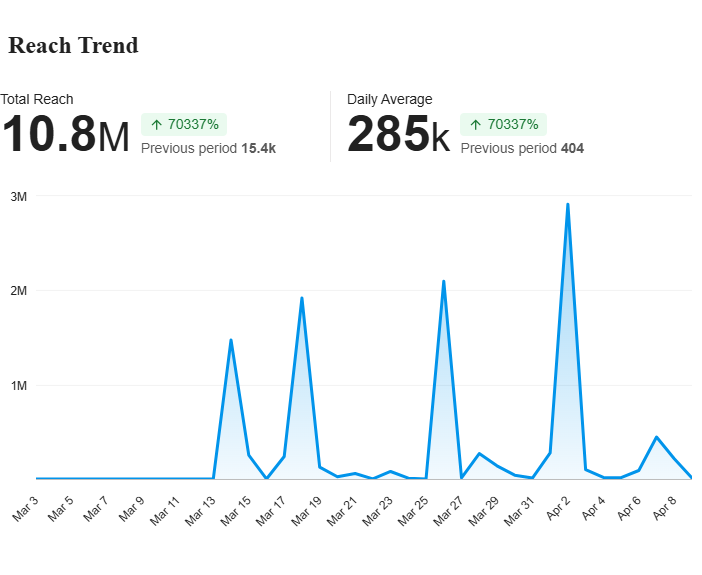
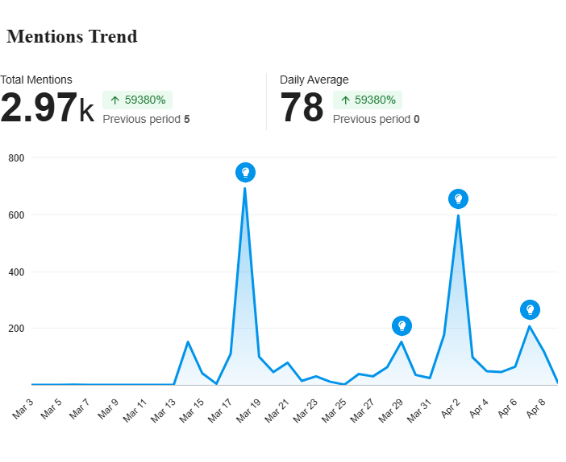
Posting under the hashtag "#تدويل_الحرمين" (Internationalizing the Two Holy Mosques) began on March 13, 2025, reaching its first peak on March 14, and hitting its highest posting rate on March 18. The hashtag's reach and spread peaked on April 2, 2025; by then, it had surpassed 10 million impressions in less than a month, with an average daily reach of around 300,000—an especially high figure considering the total number of posts did not exceed 3,000.
”
Posting under the hashtag "#تدويل_الحرمين" (Internationalizing the Two Holy Mosques) began on March 13, 2025, reaching its first peak on March 14, and its highest posting rate on March 18. The peak in reach and spread occurred on April 2, 2025; by that time, the hashtag had surpassed 10 million impressions in less than a month, with an average daily reach of around 300,000—a remarkably high rate given the total number of posts did not exceed 3,000.
The hashtag was initiated by a verified Saudi account under the name “Almotaz Mirah | المعتز الميره @Motaz_Mirah,” who included "#تدويل_الحرمين" in a post featuring screenshots from an account called "ذئب بريء" (Innocent Wolf), stating in the tweet that calls for internationalization constitute "a declaration of war on the Kingdom."
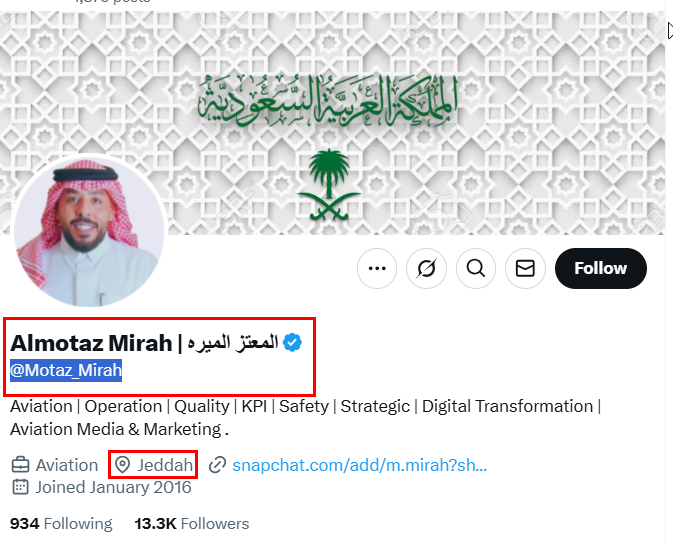
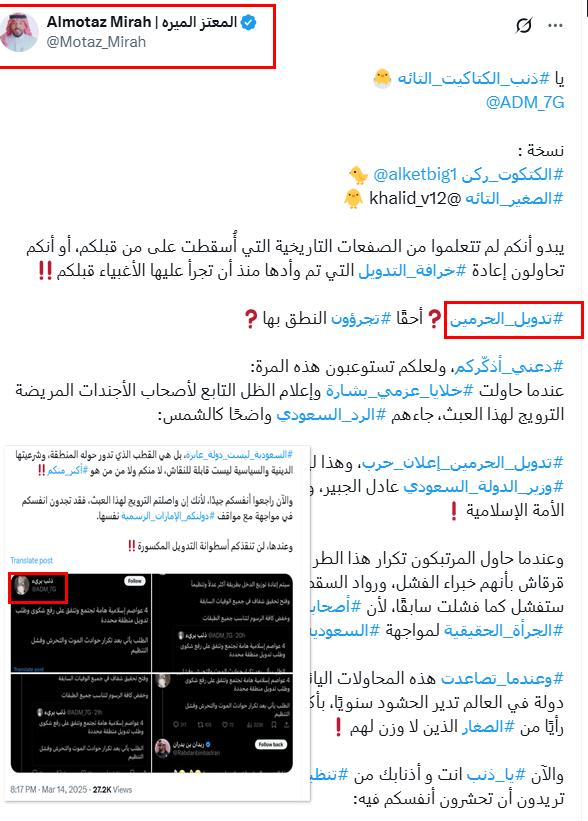
The account (Innocent Wolf @ADM_7G) published a post claiming that four Muslim countries had agreed to file a complaint calling for the internationalization of a specific area—a claim for which no credible source could be found. The account belongs to a newly created Emirati user and appears to be a replacement for another account with the same name. It lists its location as Washington D.C., while its banner features the phrase "United Arab Emirates." Both accounts use a logo resembling that of official Emirati institutions, particularly those associated with security agencies.
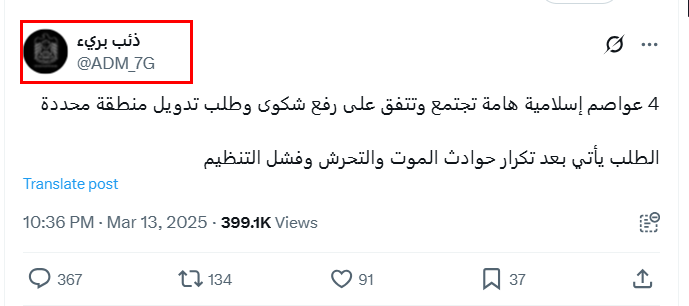
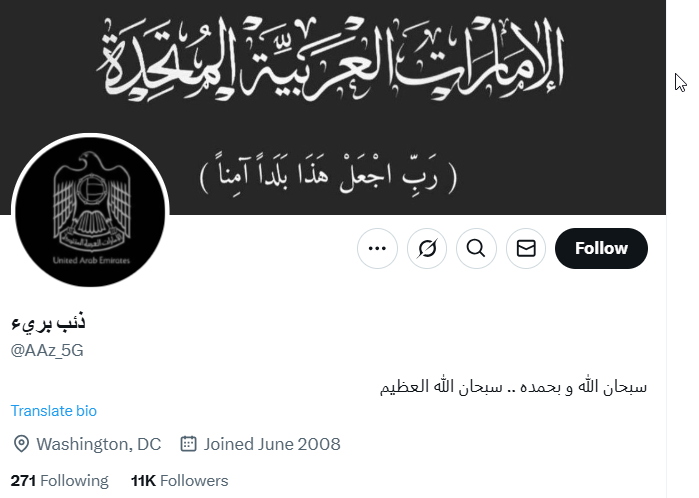
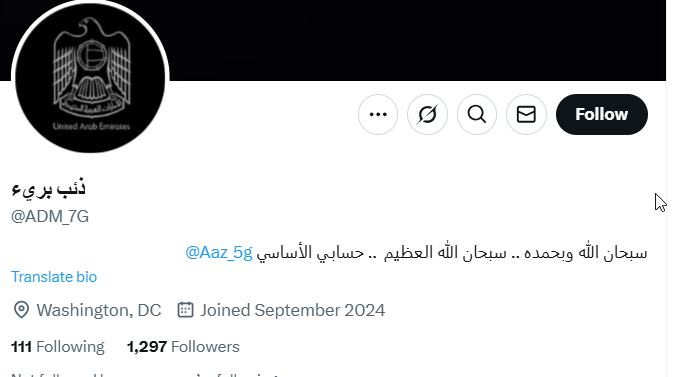
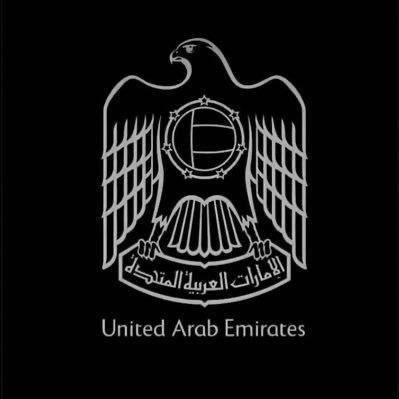
The account was also linked to several other Emirati accounts, confirming that it was indeed Emirati and that the claims it posted had been amplified. The hashtag quickly turned into a digital campaign involving both Saudi and Egyptian accounts.
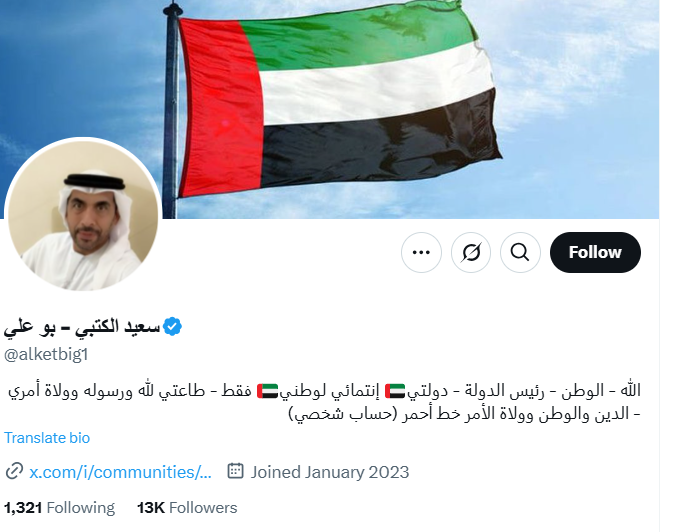
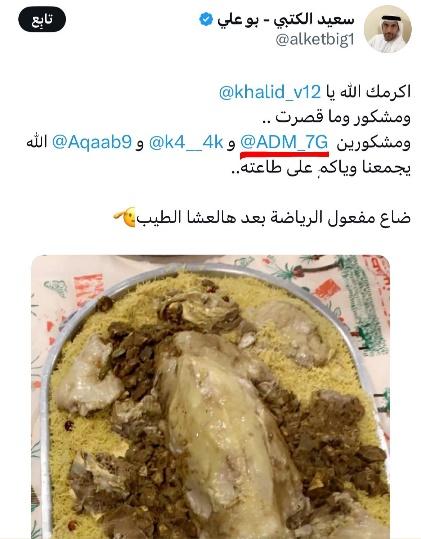
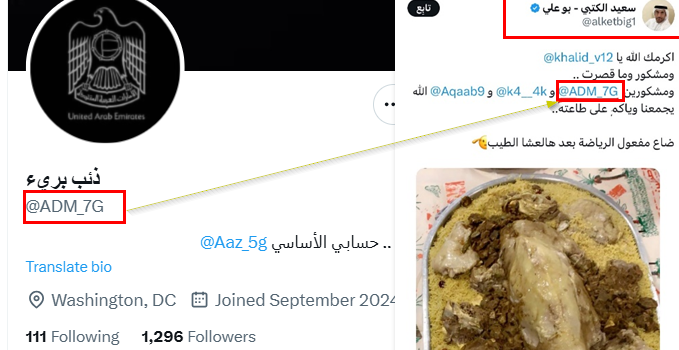
Egyptian or Saudi Campaign?
Initial indicators from Meltwater raised suspicions about the campaign. An analysis of posting patterns related to the hashtag #تدويل_الحرمين (Internationalizing the Two Holy Mosques) showed that nearly three-quarters of the posts were comments, while retweets and quote tweets together made up about a quarter of the content. Meanwhile, original content accounted for only 1.6% of total posts under the hashtag.
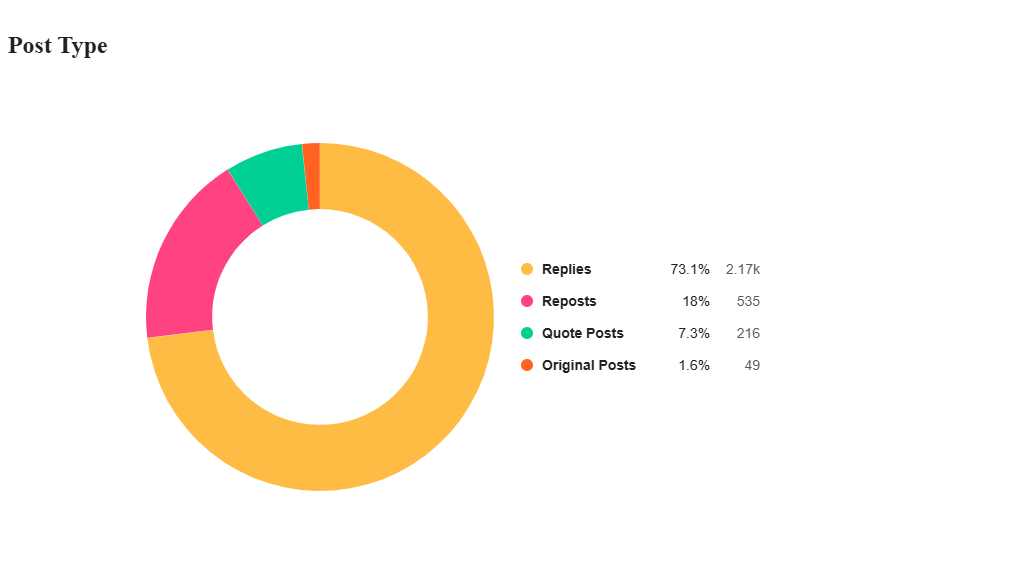
To understand the reason behind this distribution in post types, we referred back to the graph illustrating interaction trends throughout March and early April. The beginning of posting under the hashtag #تدويل_الحرمين (Internationalizing the Two Holy Mosques) was accompanied by a noticeable spike in the rate of reposts. This was followed by a drop in reposts on March 18, coinciding with a sharp rise in the number of replies.
Later, as replies dropped to their lowest levels on March 25, the rate of reposts began to climb again. Replies then experienced another surge starting March 29, reaching their second peak on April 2.
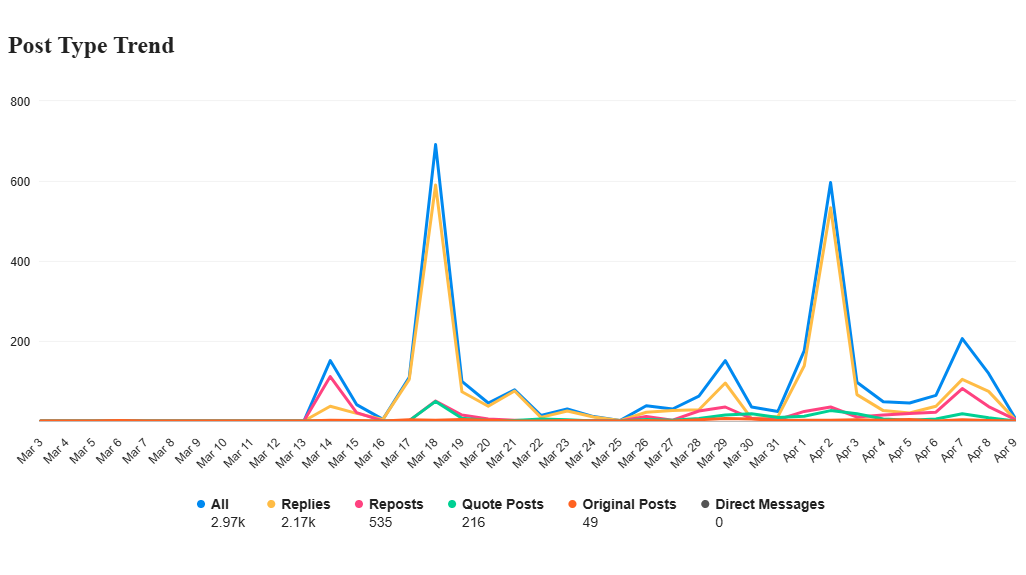
This suggests that the activity of accounts posting under the hashtag #تدويل_الحرمين (Internationalizing the Two Holy Mosques) was not primarily focused on reposting for the sake of amplification alone, but rather aimed at generating comments and replies. These interactions, in turn, played a more significant role in amplifying the hashtag’s content.
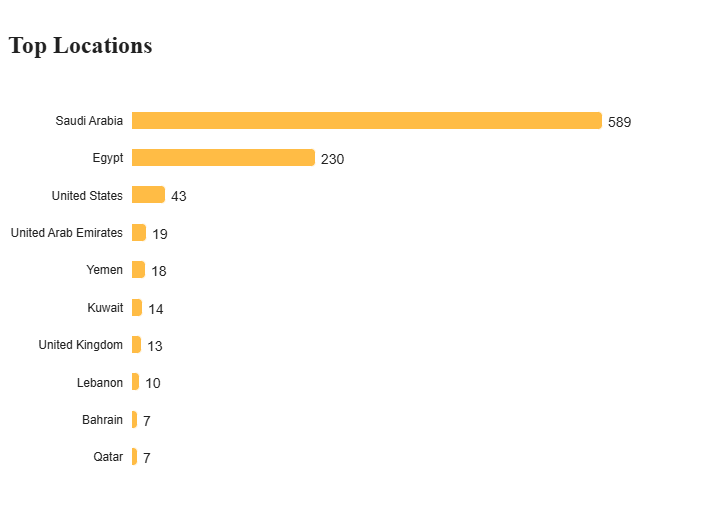
This helps explain why the majority of participants posting under the hashtag #تدويل_الحرمين (Internationalizing the Two Holy Mosques) were from Saudi Arabia, even though the hashtag itself was primarily directed against the Kingdom. This is evident from the negative word cloud associated with the hashtag’s posts, which features numerous expressions attacking Saudi Arabia and Saudis.
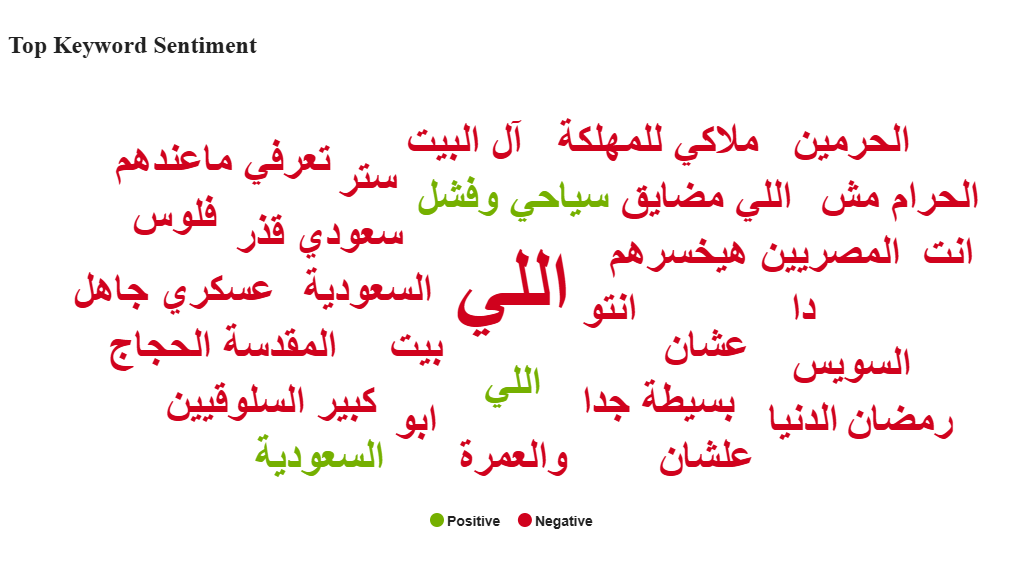
The heavy participation of Saudi accounts in the #تدويل_الحرمين (Internationalizing the Two Holy Mosques) hashtag was clearly reflected in the word cloud, which included a number of words, expressions, and hashtags commonly used by Saudi users—such as “Adel Al Jubeir,” “Saudi Arabia,” and “Al Madinah Al Munawwarah.” This influence also extended to the list of most associated hashtags, where those frequently used by Saudi accounts topped the list, followed by hashtags that repeatedly appeared in posts by Egyptian users.
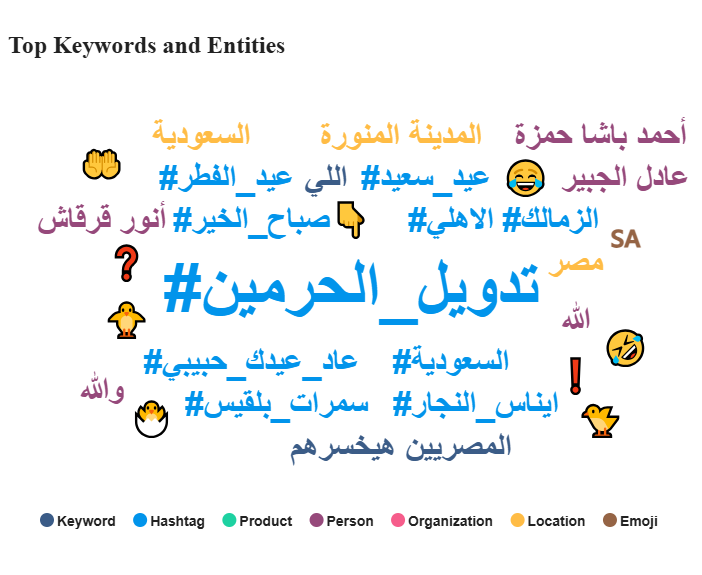
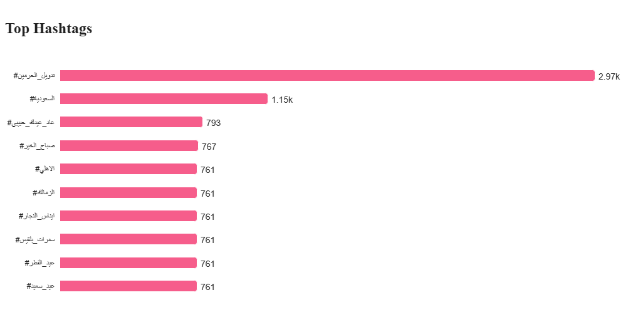
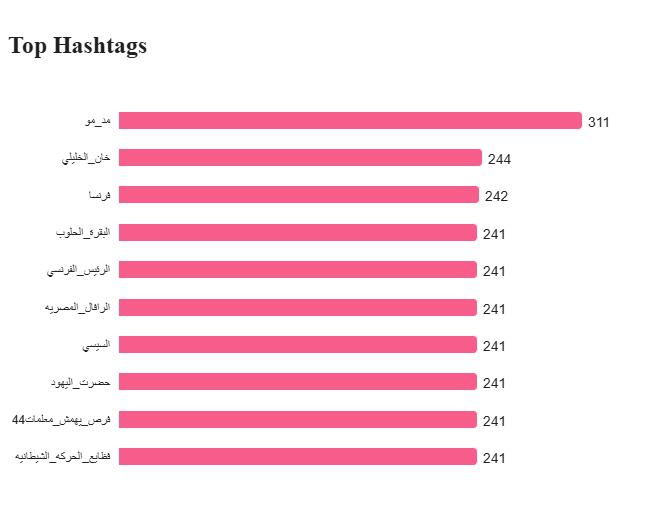
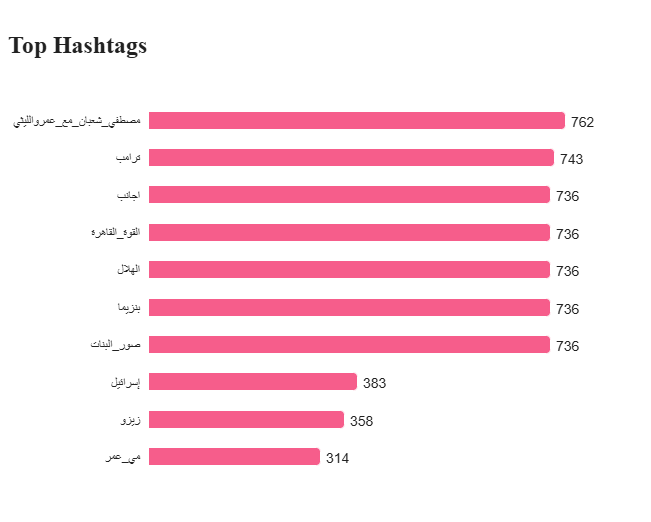
Despite the dominance of Saudi accounts in terms of volume of participation, analyses showed that the most widely engaged and circulated posts under the hashtag #تدويل_الحرمين (Internationalizing the Two Holy Mosques) came from Egyptian accounts. Many of these accounts were observed to use profile pictures of pharaonic statues or fictional images, and carried notable names such as: "Kemet, Egyptian Kingdom," "Daughter of My Great Ancestors," and "NourAdam."
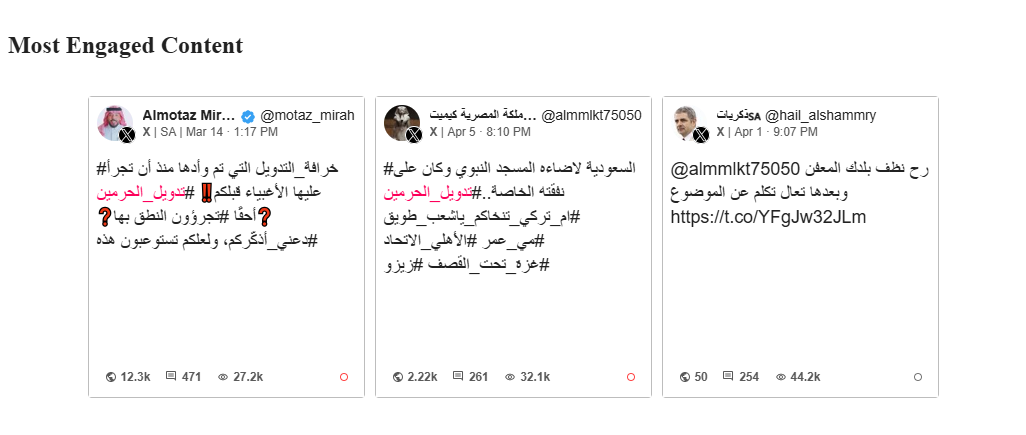
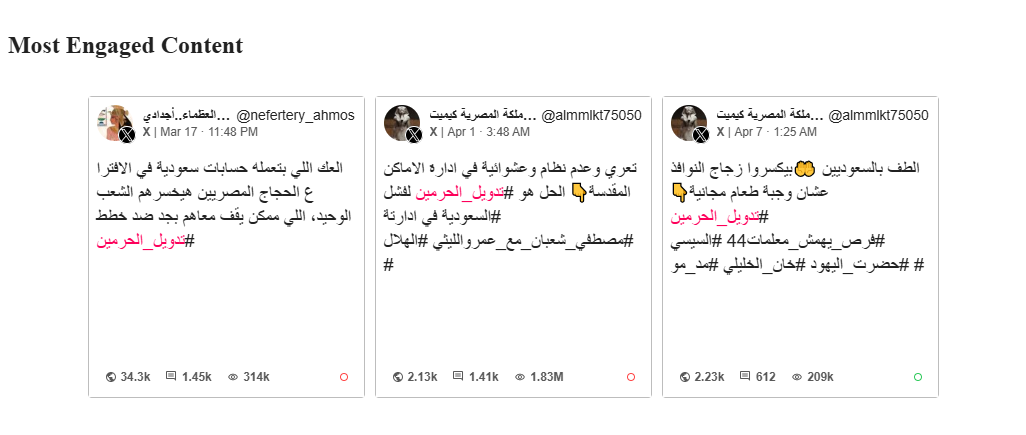
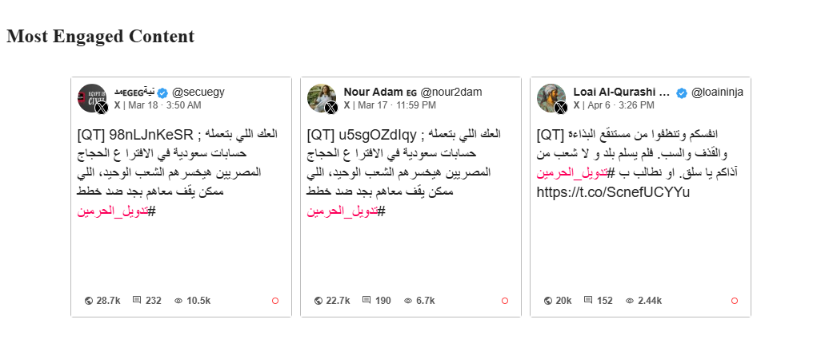
This raises a question about the nature of these accounts and their pattern of participation, and whether there is deliberate amplification of the hashtag through replies.
Egyptian Accounts Hating Refugees and Proud of Kemetism
The review and verification process of the most prominent Egyptian accounts participating in the posting under the hashtag “Internationalizing the Two Holy Mosques” revealed that they are divided into two main groups.
The first group consists of accounts that take pride in their Ancient Egyptian origin and adopt an antagonistic rhetoric against refugees, often using fake profile pictures. Among these accounts is the account (Daughter of My Great Ancestors @Nefertery_Ahmos), which participated in the hashtag, and in its description, it uses the hashtag #توطين_اللاجئين_خطيئة (Localizing Refugees Is A Sin), frequently posting provocative content against refugees in Egypt.
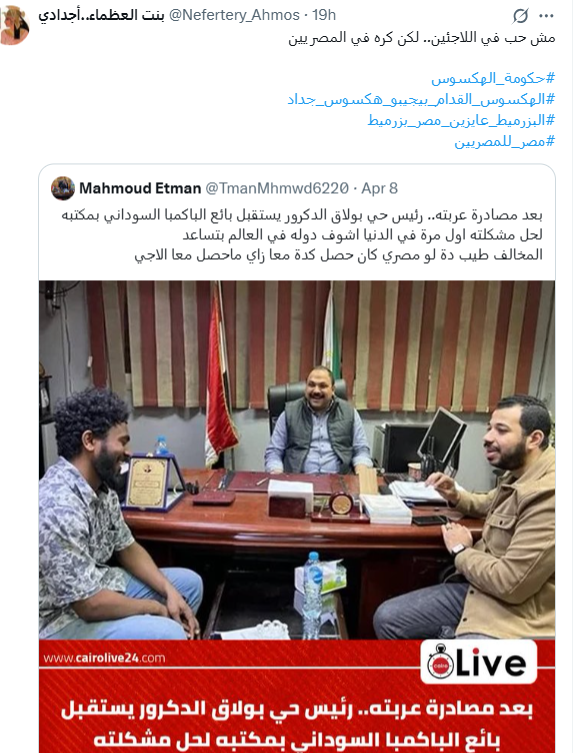
The account (Nour Adam @Nour2dam) reposted what was posted by the account (Daughter of My Great Ancestors @Nefertery_Ahmos), and upon reviewing the account's archive, it became clear that it adopts the same hateful rhetoric against refugees and calls for their deportation from Egypt.
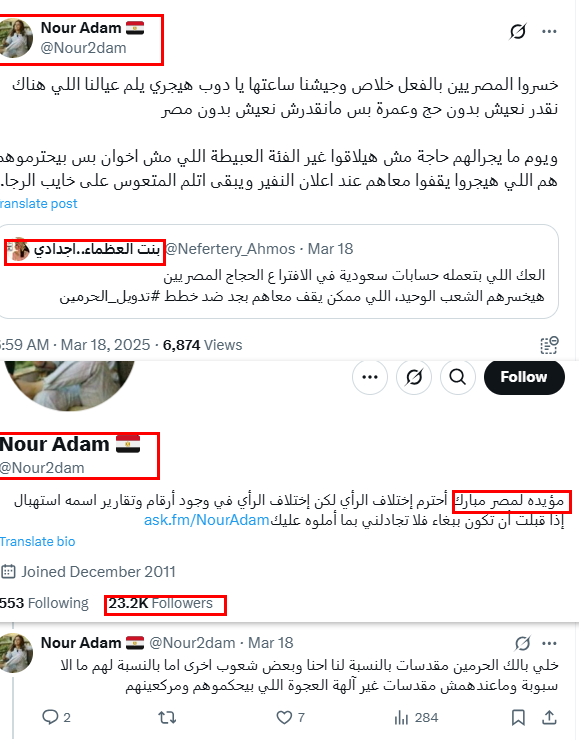
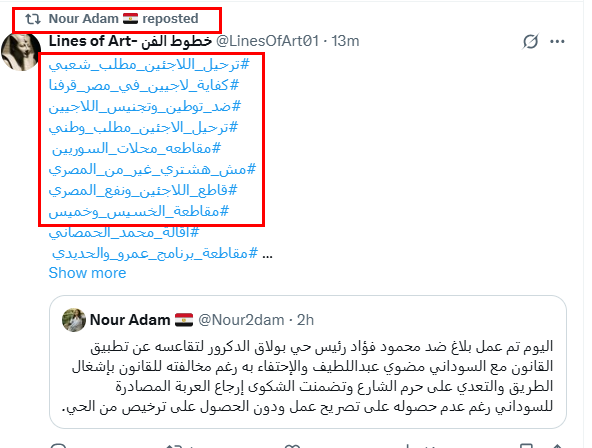
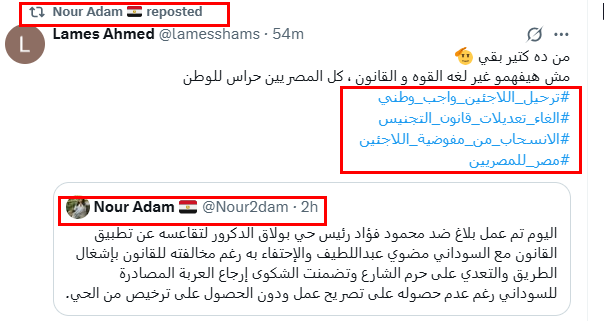
The accounts (Bint Saltah Baba @imyy38) and (Hala 🇪🇬 𓉔𓄿𓃭𓄿 @Hala_mumzy100) follow the same approach. They were created in 2011 and have a large number of followers. Their posts clearly show pride in Ancient Egyptian heritage, as well as explicit support for the ruling regime in Egypt. They also adopt a provocative and hostile rhetoric towards refugees within the country.
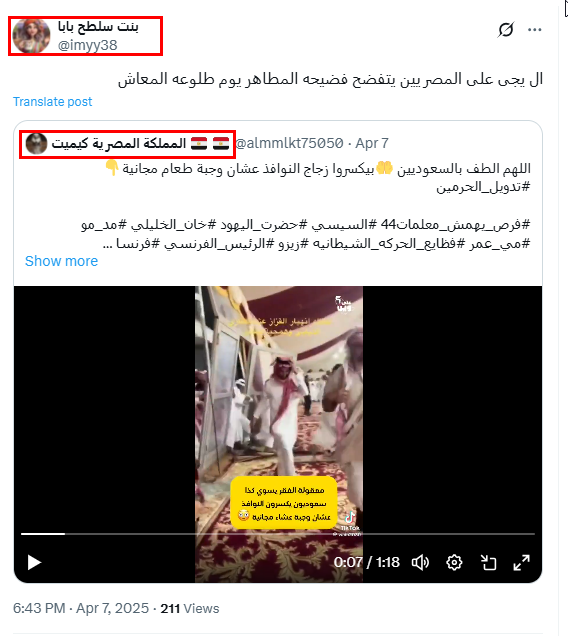
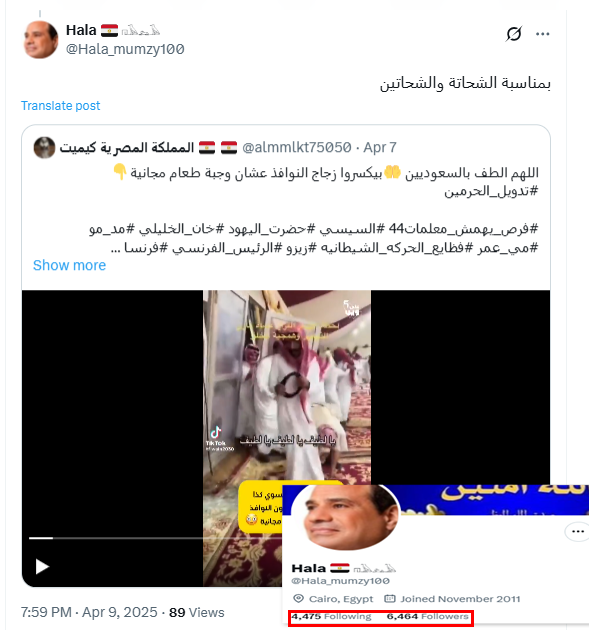
The two accounts participated in the "#تدويل_الحرمين" (Internationalizing the Two Holy Mosques) campaign by interacting with and resharing posts published by an account called (Kemet, Egyptian Kingdom 🇪🇬 🇪🇬 @almmlkt75050). This is a newly created account that we previously observed participating in an anti-refugee campaign, and confirmed that it is an automated account inciting hostility against refugees in Egypt.
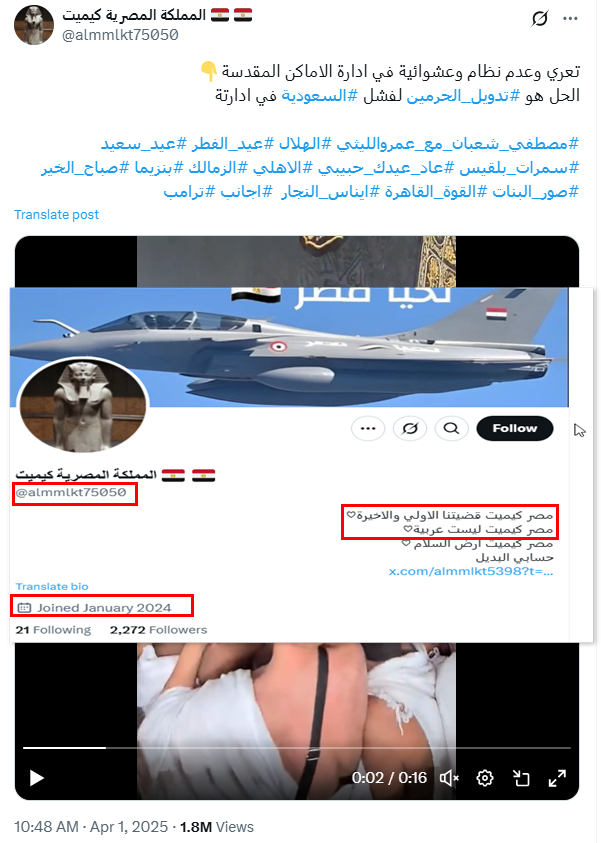 z
z
In addition to the account (Kemet, Egyptian Kingdom), research revealed that there were several other similar accounts that formed the second group of Egyptian accounts interacting with the hashtag "#تدويل_الحرمين" (Internationalizing the Two Holy Mosques). These were all newly created accounts, loyal or supportive of the ruling regime in Egypt, and they also adopted an anti-refugee discourse, inciting their expulsion from Egypt.
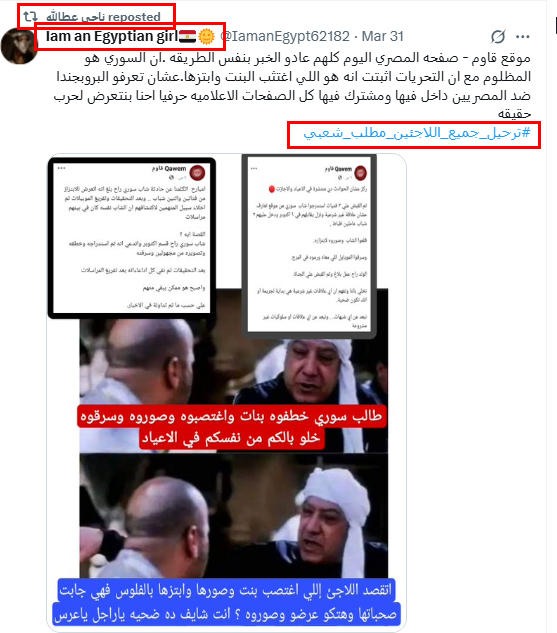
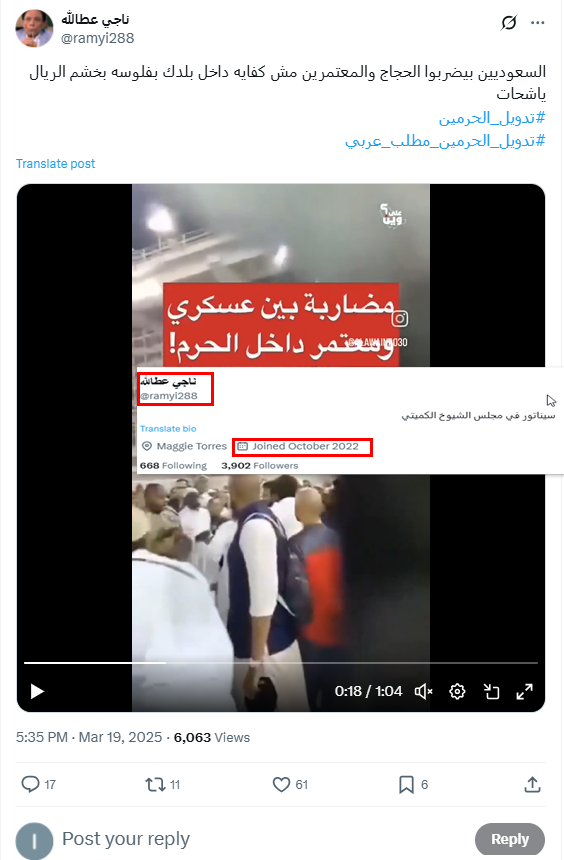
A group of other accounts also interacted with the campaign, including the following: (Nagi Attallah @ramyi288), (Megna @Megna1180051), (AlDeeb 🇪🇬🐺😉 @MO_Aldeeb), and (♍️🇪🇬🦅👑Queen Mai Salman👑🦅🇪🇬♍️ @mai61772). These accounts share that they are Egyptian. They contributed to amplifying the spread of the hashtag “Internationalizing the Two Holy Mosques” and participated heavily in engaging with Saudi accounts within the discussion. However, all of these accounts are fake and newly created. Their activity pattern relies on amplifying hashtags and using targeted propaganda techniques, with repeated hate speech against refugees in Egypt.
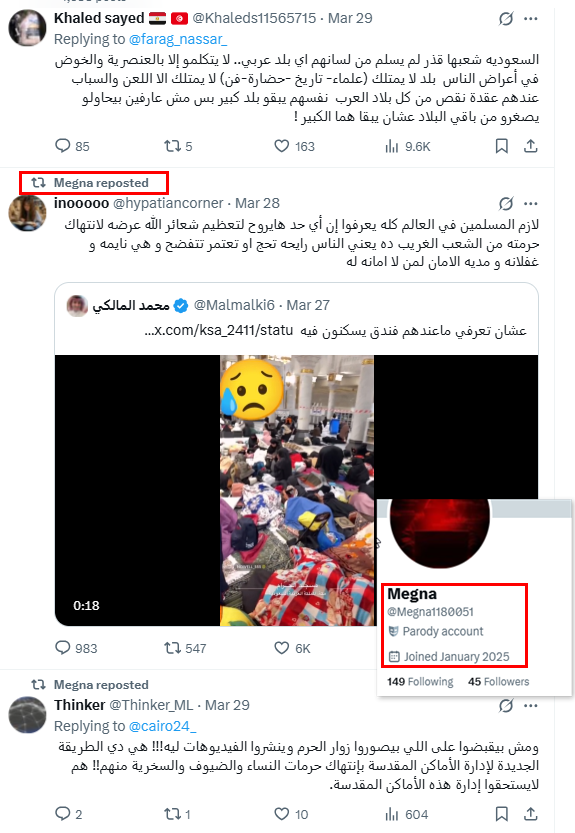
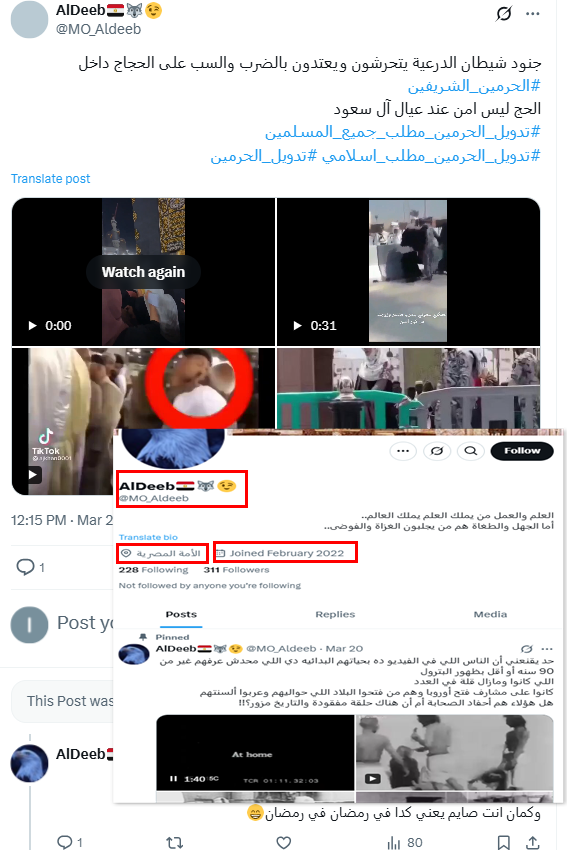
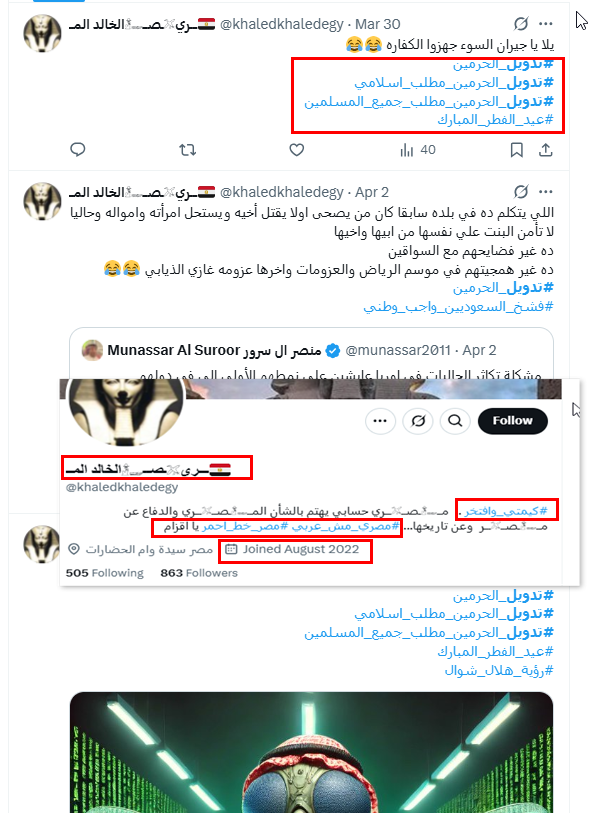
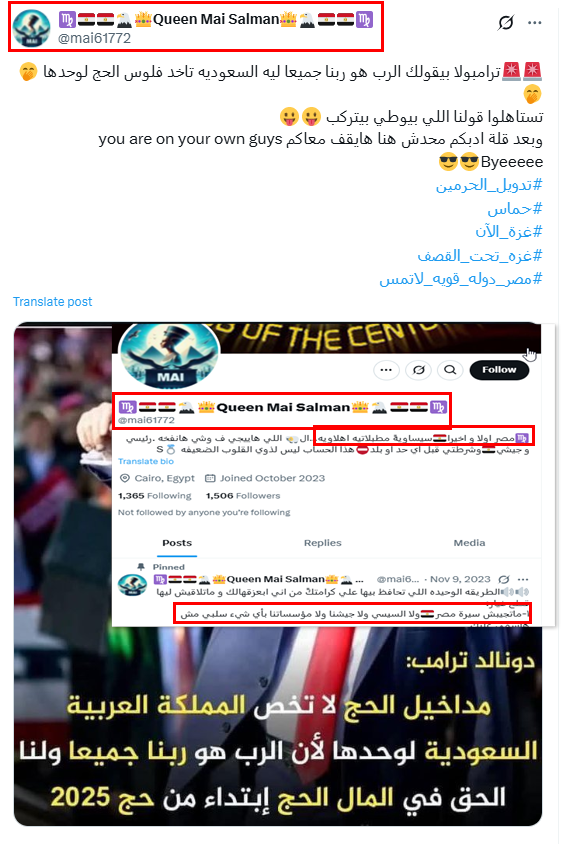
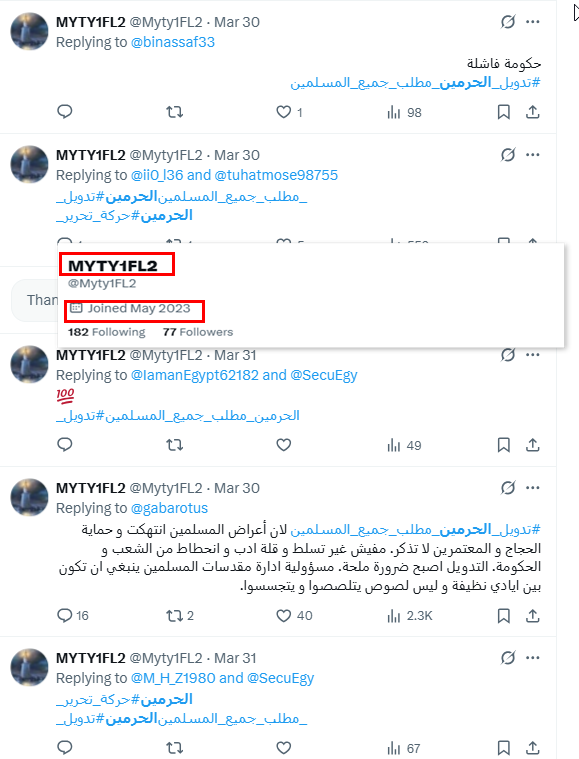
Saudi Trolls, Insults and Slander
On the other hand, many Saudi accounts interacted with the hashtag “Internationalizing the Two Holy Mosques” through comments and quote tweets. Notably, the majority of these accounts—most of which were newly created and used fake names and profile pictures—had an aggressive tone, relying heavily on insults and slander.
”
On the other hand, many Saudi accounts engaged with the hashtag "#تدويل_الحرمين" (Internationalizing the Two Holy Mosques) through comments and quote tweets. Notably, the majority of these accounts—newly created and using fake names and profile pictures—were characterized by an aggressive tone, relying heavily on insults and defamatory language.
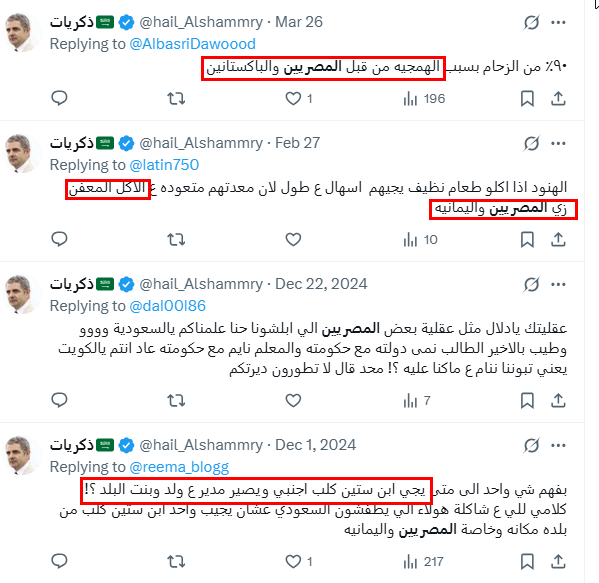
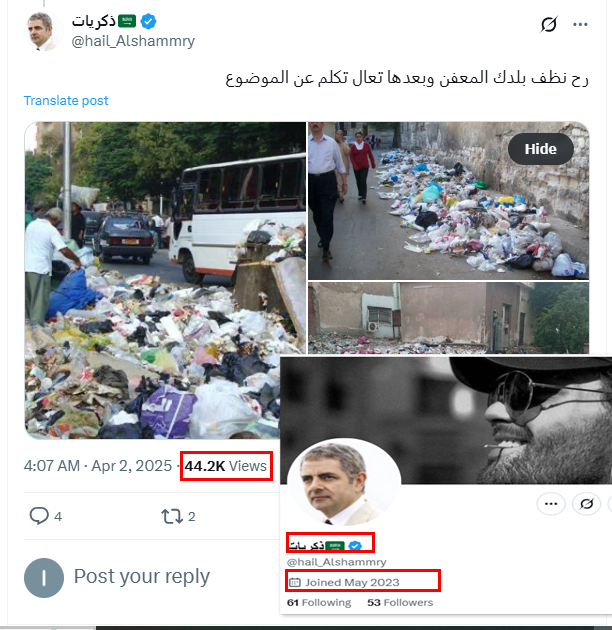
For example, the verified account (@hail_Alshammry), which features a photo of a famous American actor, focused its comments on accusing Egyptians and Pakistanis of being “barbaric and filthy.” The account also employed hate speech directed at any foreigner working in Saudi Arabia.
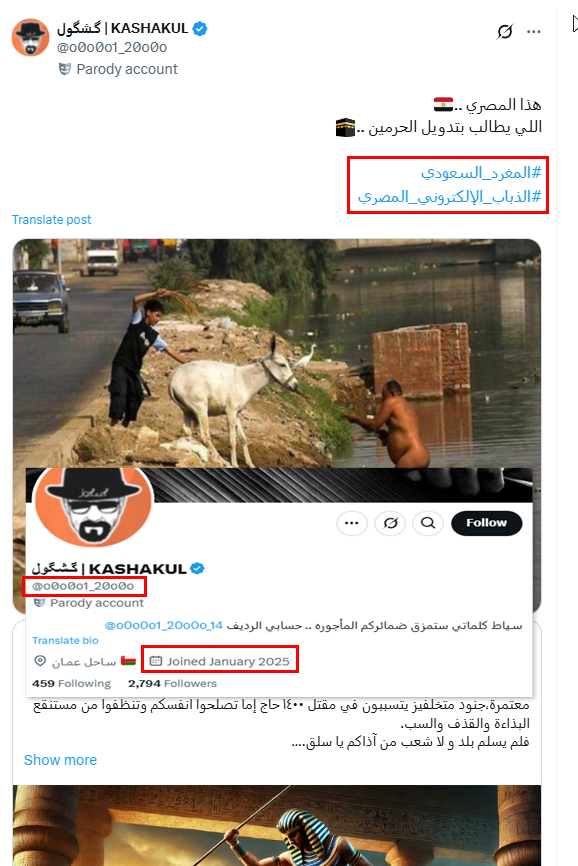
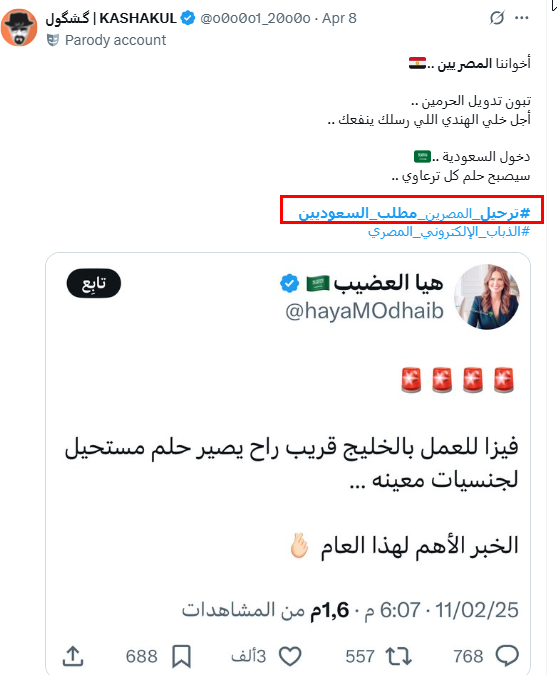
The same hostile rhetoric was echoed by the verified account (@o0o0o1_20o0o), known as "گـشگول | KASHAKUL." This account does not use a real profile picture and tends to post tweets that glorify Saudi Arabia and promote political propaganda in favor of its ruling regime. It lists its location as the coast of Oman. The account engaged with the hashtag "#تدويل_الحرمين" (Internationalizing the Two Holy Mosques) using hate speech against Egyptians, and also used the hashtag "#ترحيل_المصريين_مطلب_سعودي" (Deporting Egyptians is a Saudi Demand) to call for the expulsion of Egyptians from Saudi Arabia.
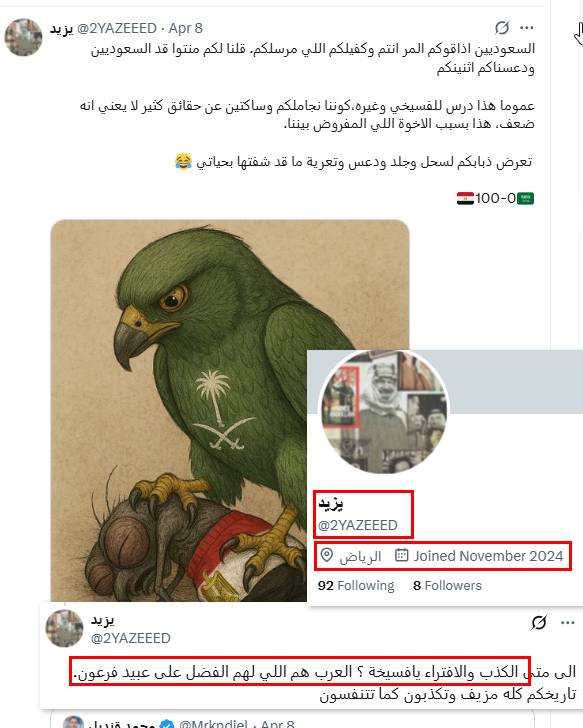
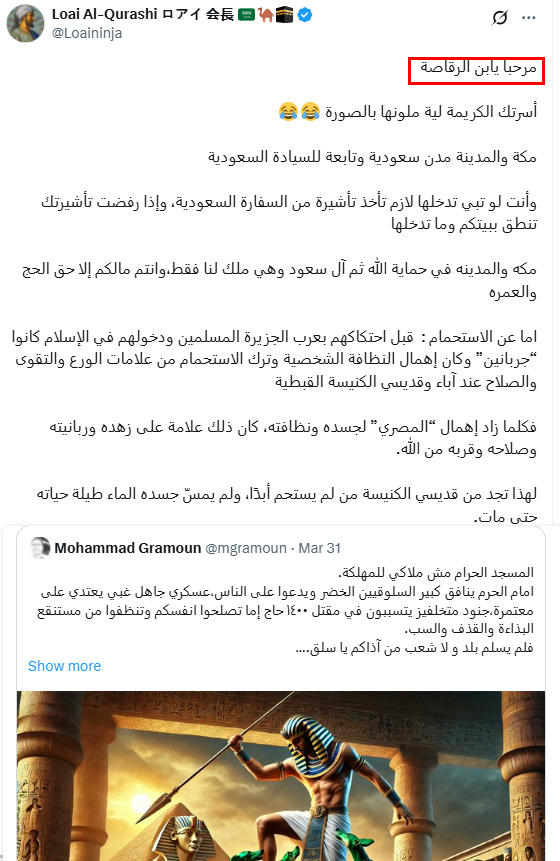
Many newly created Saudi accounts have recently interacted in a coordinated manner, repeatedly spreading hate speech against Egypt and Egyptians. This included insults, slander, and derogatory language, alongside a flood of posts glorifying Saudi Arabia and its rulers.
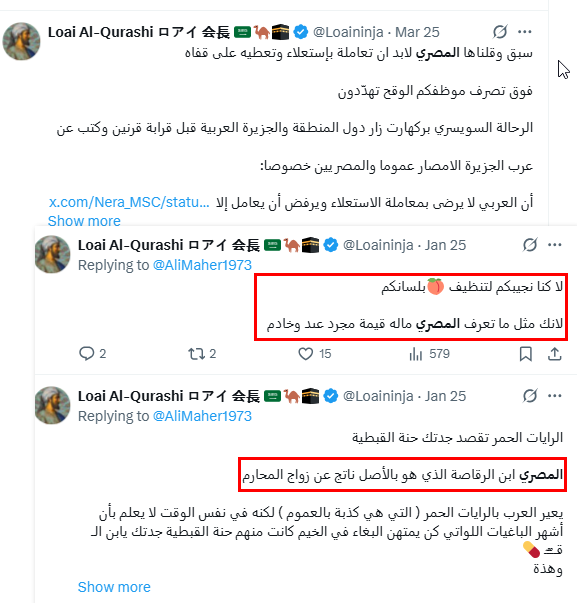
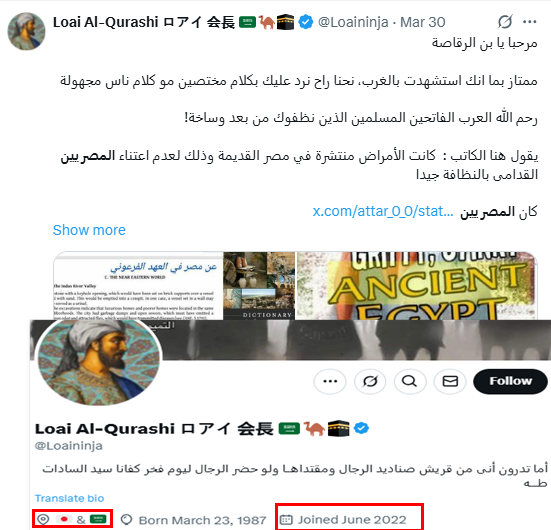
Troll Networks and Tactics of Amplification
To identify the most active accounts within the hashtag "Internationalizing the Two Holy Mosques”, we collected all related posts — totaling 2,975 — and conducted a detailed analysis of their data. The analysis resulted in identifying a list of the most active and influential accounts associated with this hashtag.
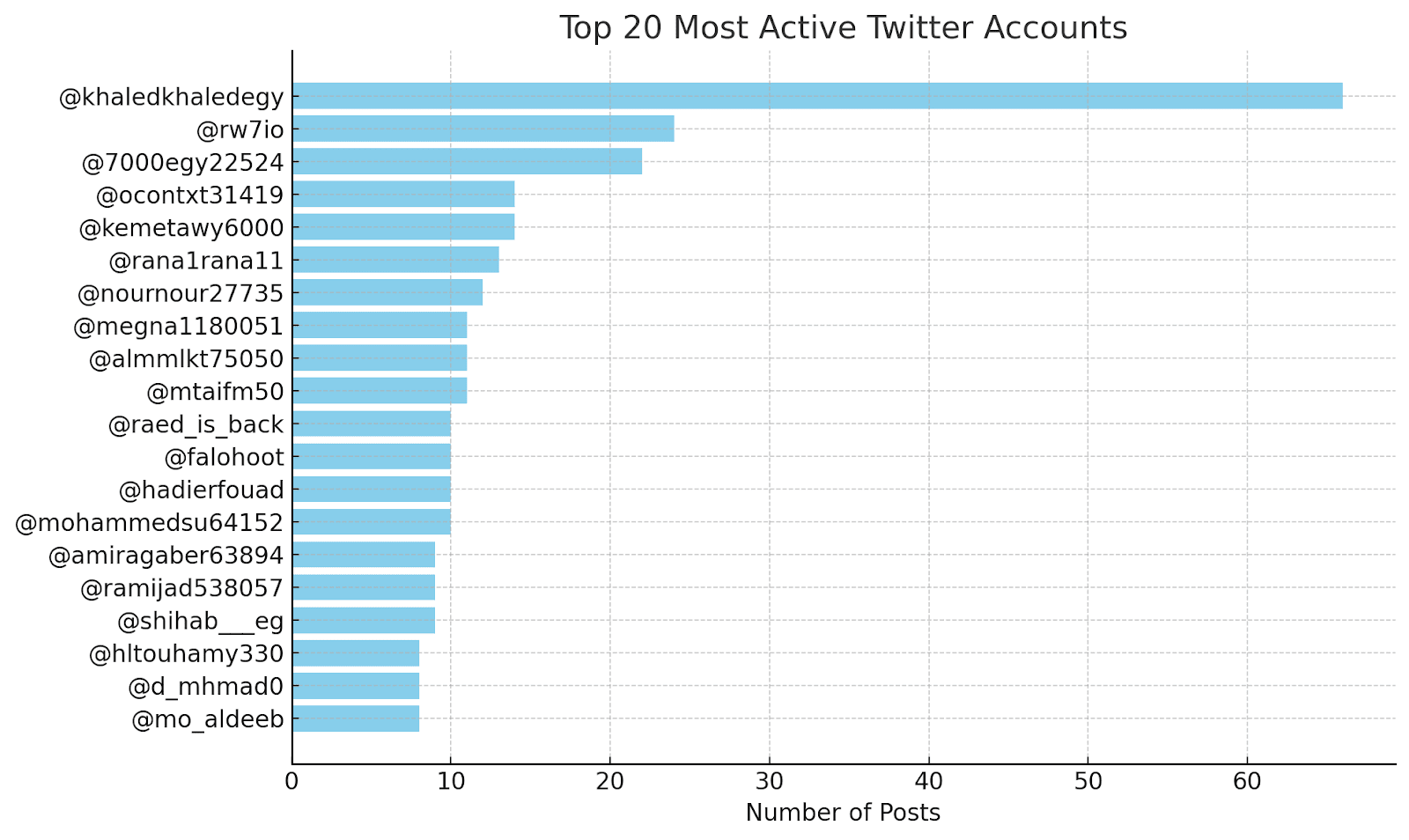
Topping the list was the account @khaledkhaledegy with 66 posts. The coded analysis we conducted on its interaction pattern showed that its peak activity occurred between 6:00 AM and 10:00 AM, during which it posted 32 times in short intervals. This rapid and continuous posting pattern indicates a repetitive behavior, suggesting that the account may be automated or inauthentic.
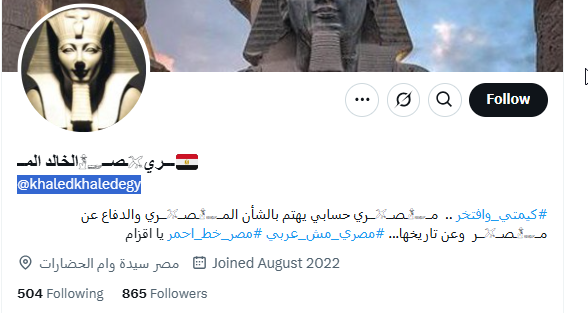
.png)
Ranked second was the Saudi account (1727م | يوم بدينا 🇸🇦🥁 @rw7io), a recently created profile that engaged with 24 posts, all in the form of replies. Applying the same coded analysis revealed that its peak activity occurred between 1:00 PM and 2:00 PM, with 75% of its posts published at fixed intervals with no time variation. Additionally, the presence of repetitive reply patterns strongly suggests that the account may be automated or inauthentic.
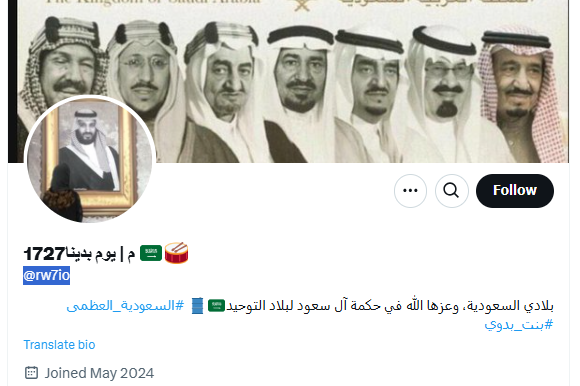
.png)
Ranked third was the account (𓂀 🇪🇬 丂HίHคB@7000Egy22524), which is also recently created. Although it is an Egyptian account, the coded analysis showed that its interaction pattern mirrors that of the previous Saudi account @rw7io—posting intensively at specific times without time gaps. This raises serious doubts about the authenticity of the account's engagement.
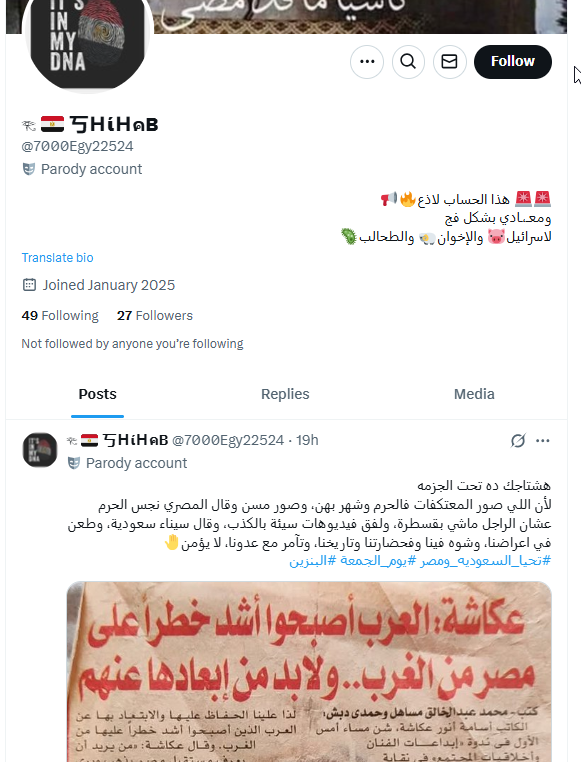
.png)
In fourth place, a new pattern of accounts emerged, represented by the account (Colonel Rabah Al Enezi, Servant of the Two Holy Mosques @OContxt31419), which appears to be a Saudi account. Although it shares similarities with previous accounts—being newly created and exhibiting automated posting behavior—the notable aspect of this account is that it posted content attacking Saudi Arabia and reshared posts from the account "Kemet, Egyptian Kingdom". This raises questions about its motives and objectives.
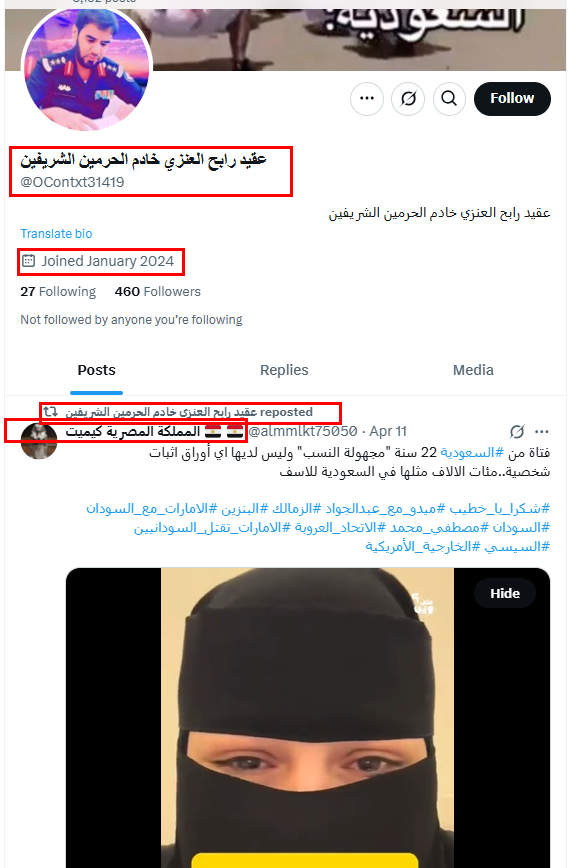
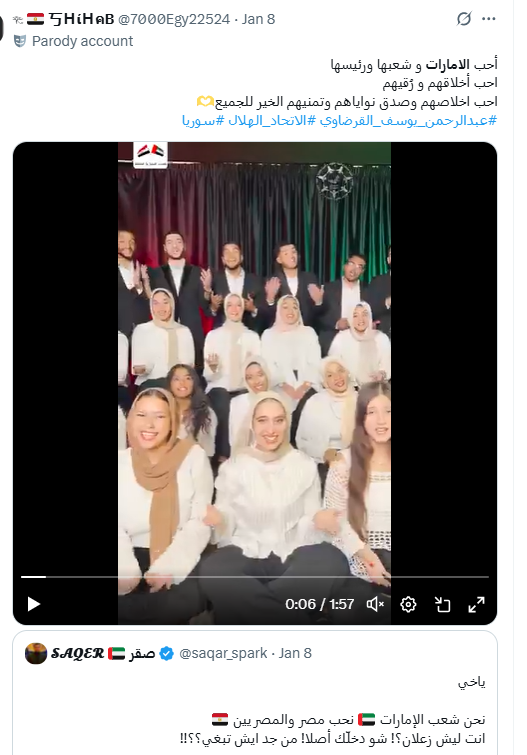
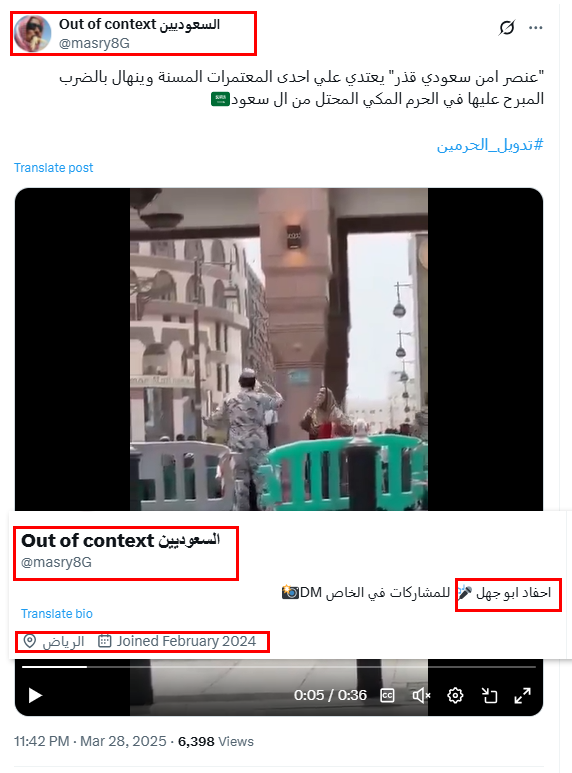
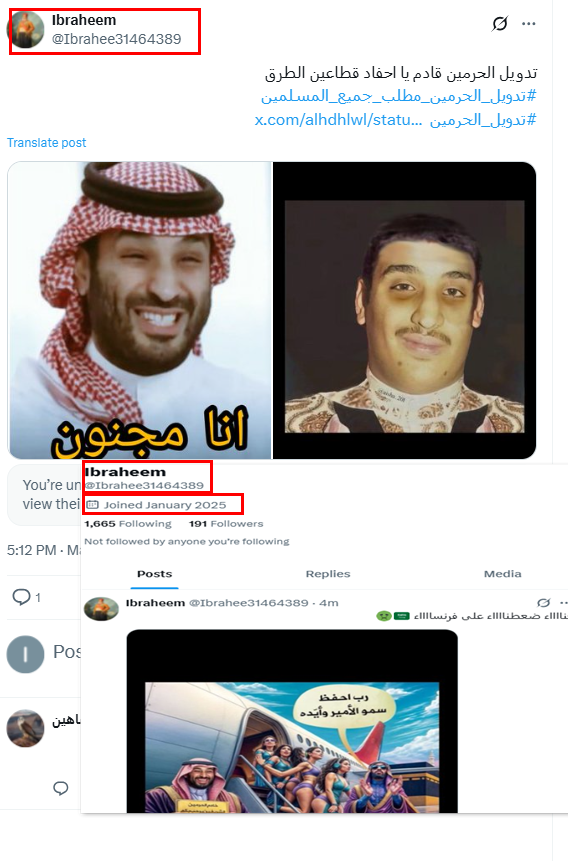

Among these accounts, the account (Ibraheem@Ibrahee31464389) stood out. It is a newly created account that only publishes attacks on Saudi Arabia and praises Egypt. However, upon searching the account's archive, it was found to contain an old comment in which it praises the UAE. The same pattern was repeated with the account (Out of context Saudis @masry8G), which is also newly created and dedicated to attacking Saudi Arabia, even though its description mentions that the account owner resides in Riyadh.
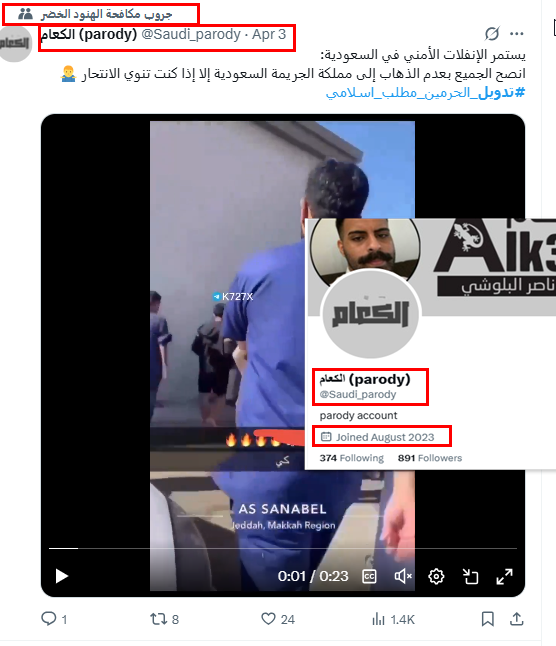
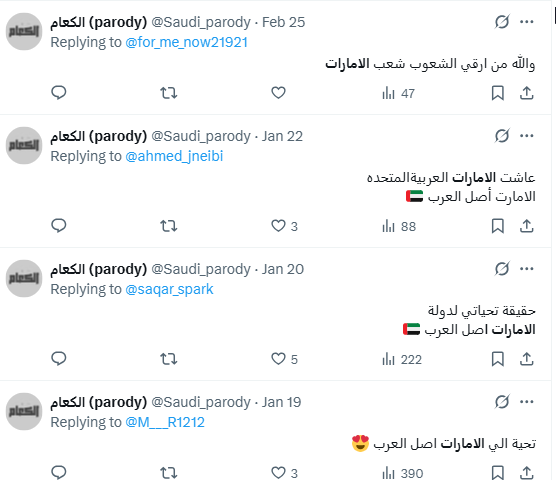
We notice the same pattern with the account @Saudi_parody, which is newly created and appears to impersonate a Saudi or at least a Gulf identity. However, it heavily attacks Saudi Arabia. Upon searching the account's archive, it was found to contain posts praising the UAE.

The analysis reveals that the networks interacting with the hashtag #تدويل_الحرمين (Internationalizing the Two Holy Mosques) are divided into three groups of accounts. The first and second groups consist of fake Egyptian and Saudi accounts, proven to be inauthentic and operating according to the pattern of electronic trolls, following a discourse of hatred, slander, and insults. The third group includes accounts that impersonate Saudi identities or at least adopt the same style in posting and commenting, but they attack Saudi Arabia and promote the UAE.
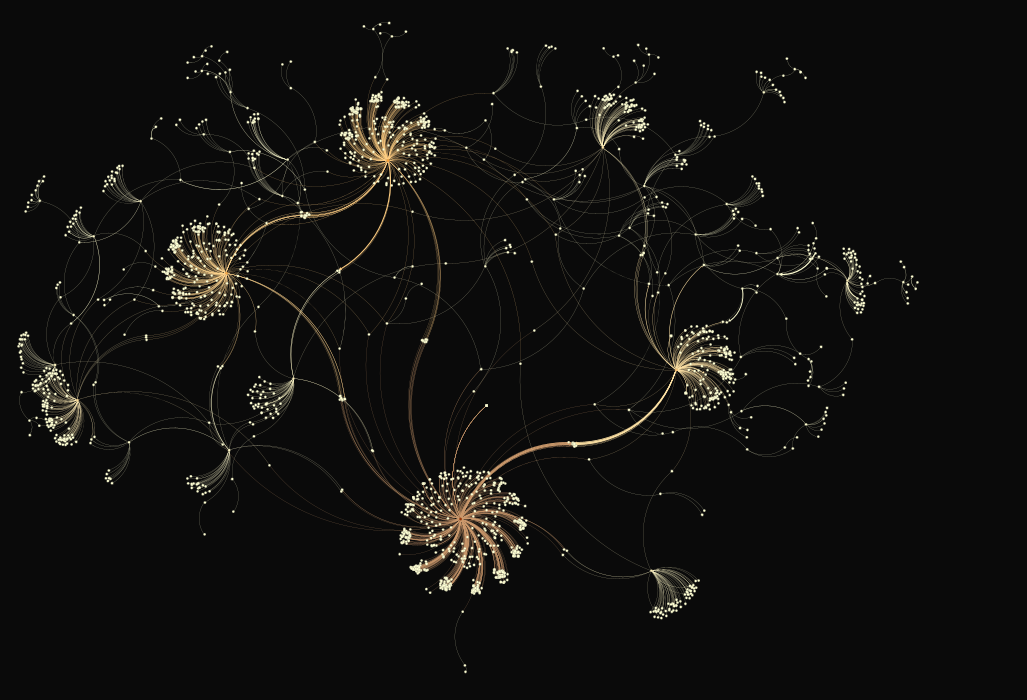
This analysis was confirmed using the Gephi program algorithm, which we used to represent the map of accounts participating in the hashtag "Internationalizing the Two Holy Mosques." In the first image, it appears that the Egyptian accounts are surrounded by a large group of Saudi accounts that interacted with them through responses.
In the second image, the interactive accounts and comments are divided into small groups and networks. Some of these networks are connected to Saudi accounts, while others are linked to Egyptian accounts. Some of these accounts impersonate Saudi identities, despite attacking them.
